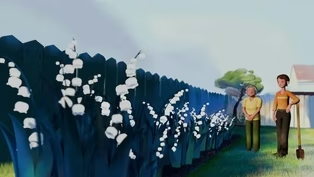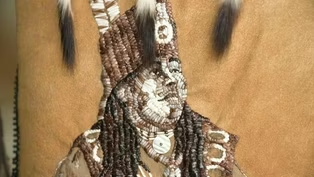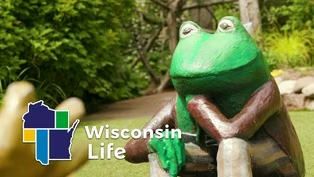
Research reveals Wisconsin loons are disappearing
Clip: Season 12 Episode 3 | 7m 14sVideo has Closed Captions
Walter Piper documents declining loon populations in northern Wisconsin.
The state's loon population is on the decline. Biology professor Walter Piper's 30-year research in northern Wisconsin documents declining reproductive success linked to water clarity and climate change. His findings could help save this iconic Wisconsin bird.
Problems playing video? | Closed Captioning Feedback
Problems playing video? | Closed Captioning Feedback
Wisconsin Life is a local public television program presented by PBS Wisconsin
Funding for Wisconsin Life is provided by the Wooden Nickel Fund, Mary and Lowell Peterson, A.C.V. and Mary Elston Family, Leon Price & Lily Postel, Stanley J. Cottrill Fund, UW...

Research reveals Wisconsin loons are disappearing
Clip: Season 12 Episode 3 | 7m 14sVideo has Closed Captions
The state's loon population is on the decline. Biology professor Walter Piper's 30-year research in northern Wisconsin documents declining reproductive success linked to water clarity and climate change. His findings could help save this iconic Wisconsin bird.
Problems playing video? | Closed Captioning Feedback
How to Watch Wisconsin Life
Wisconsin Life is available to stream on pbs.org and the free PBS App, available on iPhone, Apple TV, Android TV, Android smartphones, Amazon Fire TV, Amazon Fire Tablet, Roku, Samsung Smart TV, and Vizio.
Providing Support for PBS.org
Learn Moreabout PBS online sponsorship[loon calling] - Student: There they are, yeah.
- Walter Piper: Good eye.
- Angela Fitzgerald: The most important research on Wisconsin's iconic loons happens in the middle of the night.
- Walter: Just another routine night on the lake.
- Angela: From early on, biologist Walter Piper has had a fascination with loons.
- Healthy-looking chick.
[loon chick screeching] There he is, real fuzzy.
Hasn't gotten adult feathers in yet.
I've always been enchanted by loons.
[loon calling] As a child, I heard loons out on the lake, and they were beautiful to listen to.
[loon calling] - Angela: For more than 30 years, Walter has been watching loons during his annual pilgrimage to northern Wisconsin.
- Walter: I really love the solitude of being out on a lake in a canoe, watching loons, being sort of at one with them, watching them raise their families.
[loon calling] - Angela: Walter is a loon behavior and reproduction specialist.
His observations are providing new insights.
- When you see loons preening, after they've done all that combing of the feathers, they'll get up and straighten out their wings by doing a wing flap.
[wings flapping] - Angela: However, the calls that echo across the lakes in the Northwoods are still very much a mystery.
[loon calling] - Walter: We've only begun to scratch the surface about what they're communicating with their calls.
- Angela: Those familiar summer sounds might also fade away.
- There are projections that loons will disappear from Wisconsin in the next several decades.
- Angela: Imagine the eerie silence on northern lakes without loons.
- Walter: I'm very, very anxious about this reproductive decline that we've seen.
Reproductive success is way down.
- Angela: This wasn't the case when Walter first started his loon research in 1993.
- Walter: Back in the roaring '90s, half the pairs would have two chicks.
Now it's about three to one, one-chick broods to two-chick broods.
- Angela: That phenomenon is putting more stress on Walter's research, making his work even more crucial.
- Walter: We're going to three lakes in the Rhinelander area: Flannery, Washburn, and Manson.
[loon calling] Not too far away.
That's promising.
[owl hooting] If we're trying to catch chicks, I'll make a hoot call, which is what the adults do.
It's like the deer in the headlights.
If they hesitate and stay on the surface and they're not sure, then we grab them.
[Walter whistling] Now slow.
[whistling] [splashing] - Angela: The team will take the loons to shore to quickly conduct their research before releasing them back into the wild.
- Walter: We weigh both adults and chicks when we capture them.
That's an important measurement that we make.
And what we've noticed is that chick mass has declined substantially.
- Angela: Walter has a theory on why chick mass continues to decline.
- Walter: Loons are visual predators.
Loons have to be able to see their food to catch it and to feed it to their chicks.
So, water clarity suddenly came onto our radar.
And every time the satellite passes overhead, we can see, how clear is the water in this lake?
Water clarity in northern Wisconsin had declined on average, and this meant that the overall decline had an enormous impact on loons, we realized.
- Angela: Another threat: an explosion of black flies.
- Walter: That's related to rainfall, almost certainly related to climate change.
We've had some almost complete wipe-out years, where all May nests that loons attempt are wiped out.
Loons are just overwhelmed by black flies.
There are thousands around them, and they abandon the nest.
- Angela: The emerging danger to loons is playing out in Walter's research.
- This year, it's about 105 pairs that we follow, most of whom we've marked in previous years.
Some of them, we marked back in the '90s.
Okay, so this bird is green over copper cream.
- Angela: Walter is very familiar with the loons here on Manson Lake in Oneida County.
- Walter: The male is an 11-year-old male.
The female is from Vilas County.
These are both adults banded as juveniles, so they're especially valuable to us 'cause we know their age exactly.
We also know their natal origins, so we can learn a lot about their behavior and ecology throughout their lives.
- Angela: On this night, Walter captures their chick and brings it to shore for banding.
Despite the trends, this baby loon is defying the odds.
- Walter: Got it?
- Allie: Oh, that is a big chick.
- Walter: A big old chick.
I know, a little nipper too.
She's our biggest one by far this year.
- Angela: The chick weighs in at more than 10 pounds.
- It's almost certainly a male, to be that large this young.
It's about something like eight weeks old.
It's just huge.
Okay, that's good.
Pretty, pretty big.
Okay, back in the box he goes, before he nips me to death.
So, a very successful night.
All right, get them back to where they belong.
We breathe sigh of relief when we catch a big, healthy chick like this because it means that it's been well fed.
That says good things about Manson Lake.
It made us feel good to see such a big, strapping male chick.
- Angela: It's hard not to see the heartfelt connection Walter has with these loons.
[loon calling] - I love loons, I love being outdoors.
I don't want to let loons slip away in northern Wisconsin, or at least I wanna do everything I can to try to keep them here because they're beautiful animals and they've given me so much.
[loon calling]
A botanical garden meets children's literature
Video has Closed Captions
Clip: S12 Ep3 | 3m 18s | Angela explores Sheboygan's Bookworm Gardens, where children's books come to life. (3m 18s)
Little known truths about lilies of the valley
Video has Closed Captions
Clip: S12 Ep3 | 4m 24s | Nancy Jorgensen reflects on her grandmother's lilies that still bloom today. (4m 24s)
Porcupine quills connect past and present for artist Melanie Sainz
Video has Closed Captions
Clip: S12 Ep3 | 2m 52s | Ho-Chunk artist Melanie Sainz blends tradition and pop art with porcupine quills. (2m 52s)
Preview: Sheboygan's Bookworm Gardens
Preview: S12 Ep3 | 15s | Stories come to life at Bookworm Gardens in Sheboygan, a literary botanical oasis. (15s)
Ashland motorcyclist earns Guinness World Record after global journey
Video has Closed Captions
Clip: S12 Ep3 | 4m 44s | Bridget McCutchen becomes youngest person to circumnavigate the world by motorcycle. (4m 44s)
Providing Support for PBS.org
Learn Moreabout PBS online sponsorshipSupport for PBS provided by:
Wisconsin Life is a local public television program presented by PBS Wisconsin
Funding for Wisconsin Life is provided by the Wooden Nickel Fund, Mary and Lowell Peterson, A.C.V. and Mary Elston Family, Leon Price & Lily Postel, Stanley J. Cottrill Fund, UW...


















